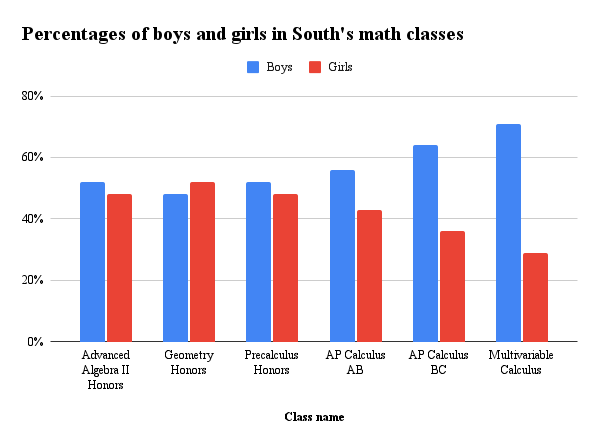Undoing gender imbalances in STEM

A graph showing the ratio of boys to girls in some of the mathematics classes at South. Data provided by Mrs. Andrea Bean, math supervisor of WW-P.
June 13, 2023
Science, technology, engineering and mathematics (STEM) are arguably some of the most demanding subjects that any high school student can explore. The STEM classes offered at South, such as AT Physics and Environmental Science, are interesting to many, but choosing which class to take is an intimidating decision, especially for girls. This is the case because often there isn’t an even balance between girls and boys in STEM classes.
As a freshman, I find this surprising. Compared to classes such as Computer Science or Physics those that require artistic abilities such as Creative Design, or Art are often subconsciously considered to have more appeal to female students.
“There are psychosocial and sociocultural influences on students’ minds,” said Dr. Richard Stec, the science supervisor of the WW-P school district. ”I think it’s historically the trends that have been consistent,”
A University of Nevada article published in Feb. 2022 titled “Gender Discrepancies in STEM” stated that “along with the centuries-long exclusion of women from pursuing a higher education, helped establish gender stereotypes that discourage women from studying and working in STEM fields.” According to the United States Census Bureau, STEM jobs in the country consisted of only 27 percent of women in 2019.
As female high school students rise up in grades and take more challenging STEM classes , many girls back down from pursuing the highest level classes. “I think it’s historically the trends that have been consistent,” said Dr. Stec.
“In my multivariable calculus class right now, there are a total of three girls in a class of twenty students,” said Aarya Mandvilkar (‘23), who is also taking AT Physics and AT Computer Science. Mandvilkar said that “it’s quite often not an even split between the genders.”
Seeing other upperclasswomen shy away from STEM classes can affect how likely it is for underclasswomen to participate in these classes in the future. “It’s common for people to do what is familiar and common when deciding what subjects to explore,” said Mandvilkar.
For girls who are exploring new topics in STEM, it can be difficult to be comfortable with an environment that is generally dominated by guys. “I definitely think that male-dominated culture decreases the likelihood of girls and women joining STEM-related activities, especially extracurricular ones,” said Dasha Kediarova (‘25), a member of the WW-P robotics team, the MidKnight Inventors. When she first joined the club, Kediarova mentioned that she felt “extremely nervous…because of the fear that I wouldn’t know enough girls to feel comfortable on the team.”
But some female students still persevere through these challenges and stay intent on their goals “I have never felt uneasy when there were not a lot of other girls in STEM-related activities,” said Diyansha Singh (‘26). She stated that she does not mind that there is often an obvious gender imbalance in many classes, and that her goals always remain her top priority. “My willingness to participate in STEM-related activities is solely based on my interest in the subject.”
However, on the bright side, the imbalance in STEM classes seems to be decreasing. AP Biology and Honors Biology teacher Dr. Meenakshi Bhattacharya said, “There is a larger representation of girls in STEM now than what I remember 15 years ago, and I feel that’s because of the support and acceptance from the community.”
Although more women are starting to put aside their fears and participate in STEM, it is still important to ensure female students are well supported. “It’s not just about encouraging young women, but also making sure men are familiar and accepting of a woman participating in male-dominated activities,” said Mandvilkar.
The undoing of the gender imbalances in STEM does not start with waiting for others to step up first, it starts with deciding to act on it yourself, with the knowledge that others will also follow in your steps.
